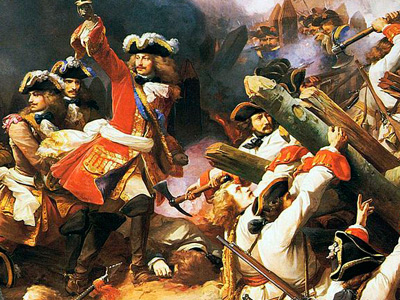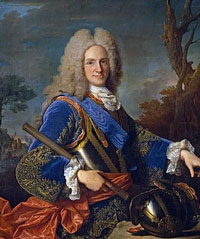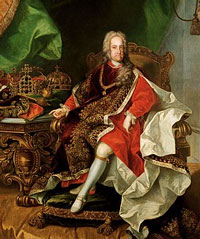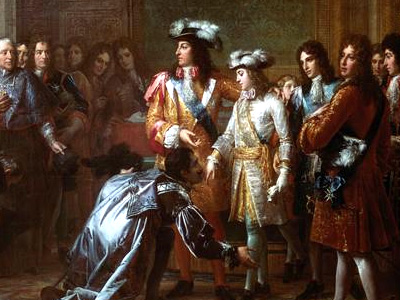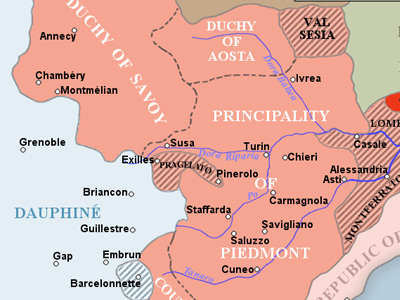War of the Spanish Succession (1702–1715)
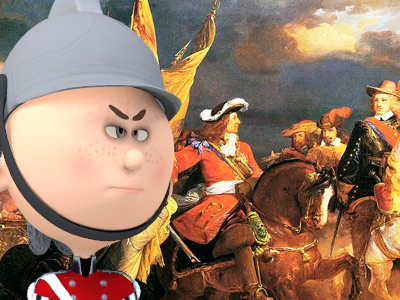
Spain and Portugal
The despatch of an Anglo-Dutch expeditionary force to Spain in 1702 was a continuation of William III's policy, using the navy to open the Strait of Gibraltar, secure Allied naval power in the Mediterranean, and cut off Spain's transatlantic economy. The Austrians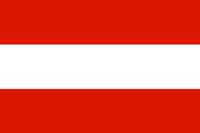 The Archduchy of Austria was a major principality of the Holy Roman Empire and the nucleus of the Habsburg monarchy. With its capital at Vienna, the archduchy was centered at the Empire's southeastern periphery. The archduchy's history as an imperial state ended with the dissolution of the Holy Roman Empire in 1806. It was replaced with the Lower and Upper Austria crown lands of the Austrian Empire. also clamoured for early naval support, claiming the sight of an Allied fleet in the Mediterranean would inspire the anti-Bourbon nobles in Naples, overawe the Francophile papacy, and encourage the Duke of Savoy to change sides. The need for a base between England and the Mediterranean was therefore essential, but the attack on Cádiz in September ended in failure and looting. However, the Allies recovered some prestige when they destroyed the Spanish treasure fleet and their French escorts anchored in Vigo Bay on 23 October. The attack did not yield as much silver as hoped, but it was to have wide implications. For King Peter II of Portugal, whose country's economy depended on oceanic trade with the Americas, the demonstration of Allied naval dominance in the Atlantic played a decisive part in persuading him to abandon his nominal alliance with France
The Archduchy of Austria was a major principality of the Holy Roman Empire and the nucleus of the Habsburg monarchy. With its capital at Vienna, the archduchy was centered at the Empire's southeastern periphery. The archduchy's history as an imperial state ended with the dissolution of the Holy Roman Empire in 1806. It was replaced with the Lower and Upper Austria crown lands of the Austrian Empire. also clamoured for early naval support, claiming the sight of an Allied fleet in the Mediterranean would inspire the anti-Bourbon nobles in Naples, overawe the Francophile papacy, and encourage the Duke of Savoy to change sides. The need for a base between England and the Mediterranean was therefore essential, but the attack on Cádiz in September ended in failure and looting. However, the Allies recovered some prestige when they destroyed the Spanish treasure fleet and their French escorts anchored in Vigo Bay on 23 October. The attack did not yield as much silver as hoped, but it was to have wide implications. For King Peter II of Portugal, whose country's economy depended on oceanic trade with the Americas, the demonstration of Allied naval dominance in the Atlantic played a decisive part in persuading him to abandon his nominal alliance with France The Kingdom of France is the historiographical name or umbrella term given to various political entities of France in the medieval and early modern period. It was one of the most powerful states in Europe since the High Middle Ages. It was also an early colonial power, with possessions around the world. Colonial conflicts with Great Britain led to the loss of much of its North American holdings by 1763. The Kingdom of France adopted a written constitution in 1791, but the Kingdom was abolished a year later and replaced with the First French Republic. and Spain
The Kingdom of France is the historiographical name or umbrella term given to various political entities of France in the medieval and early modern period. It was one of the most powerful states in Europe since the High Middle Ages. It was also an early colonial power, with possessions around the world. Colonial conflicts with Great Britain led to the loss of much of its North American holdings by 1763. The Kingdom of France adopted a written constitution in 1791, but the Kingdom was abolished a year later and replaced with the First French Republic. and Spain The Spanish Empire was a colonial empire governed by Spain and its predecessor states between 1492 and 1976. One of the largest empires in history, it was the first to usher the European Age of Discovery and achieve a global scale, controlling vast territory. It was one of the most powerful empires of the early modern period, reaching its maximum extent in the 18th century.. Although most of his ministers preferred neutrality, Peter II signed with the Allies the Treaty of Defensive Alliance and the Treaty of Offensive Alliance on 16 May 1703.
The Spanish Empire was a colonial empire governed by Spain and its predecessor states between 1492 and 1976. One of the largest empires in history, it was the first to usher the European Age of Discovery and achieve a global scale, controlling vast territory. It was one of the most powerful empires of the early modern period, reaching its maximum extent in the 18th century.. Although most of his ministers preferred neutrality, Peter II signed with the Allies the Treaty of Defensive Alliance and the Treaty of Offensive Alliance on 16 May 1703.
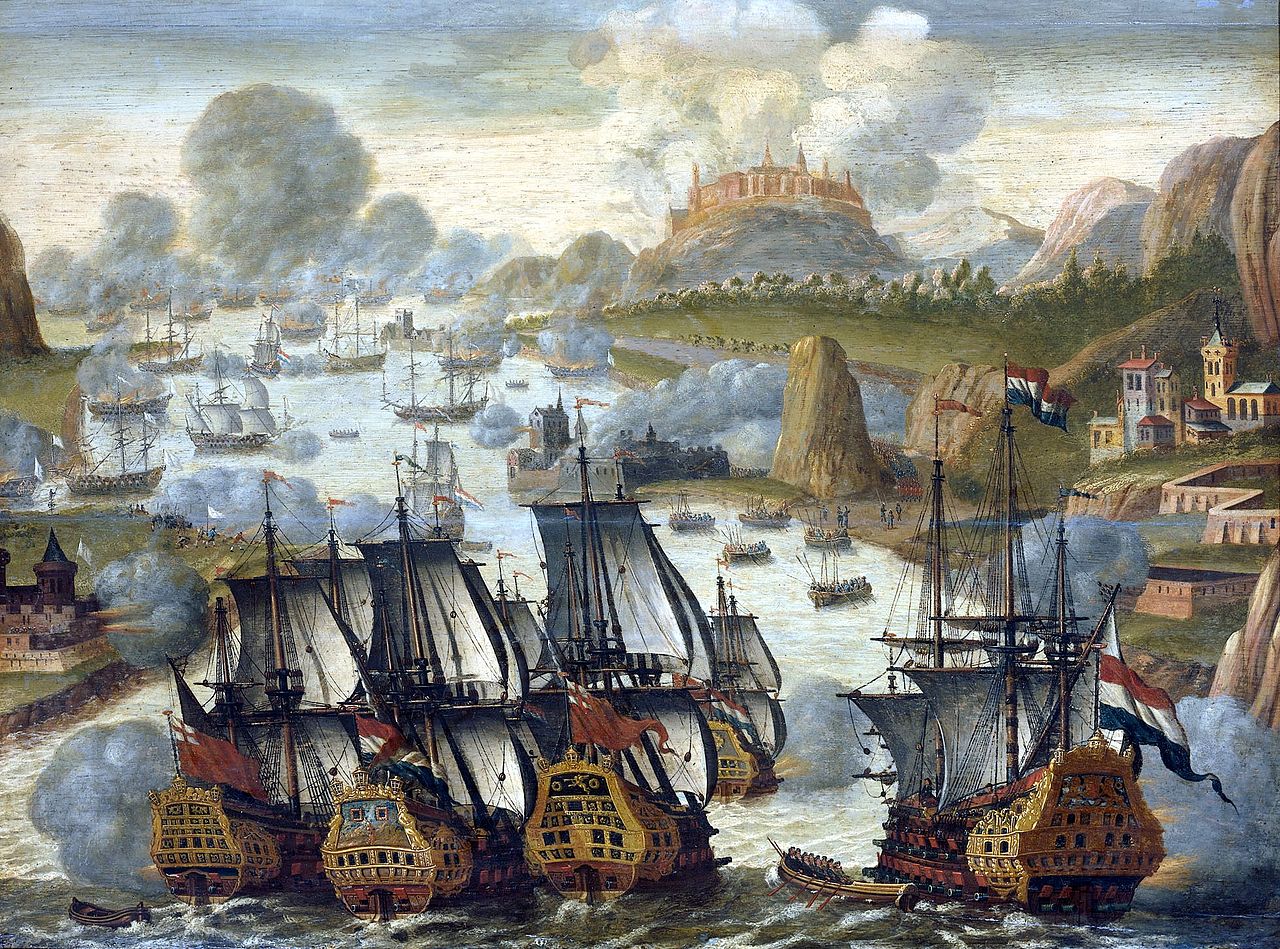
Battle of Vigo Bay. Anonymous. English and Dutch fleet sail towards the Spanish treasure ships and their French naval escorts in Vigo Bay

Battle of Vigo Bay. Anonymous. English and Dutch fleet sail towards the Spanish treasure ships and their French naval escorts in Vigo Bay
( Click image to enlarge)
The Portuguese alliance began a new era in political and commercial relations with England The Kingdom of England was a sovereign state on the island of Great Britain from about 927, when it emerged from various Anglo-Saxon kingdoms, until 1 May 1707, when it united with Scotland to form the Kingdom of Great Britain. The Viking invasions of the 9th century upset the balance of power between the English kingdoms, and native Anglo-Saxon life in general. The English lands were unified in the 10th century in a reconquest completed by King Æthelstan in 927.. However, of more immediate benefit to the Allies was the port of Lisbon which would provide all year round naval access to the Mediterranean, as well as support from the Portuguese army to fight for the Grand Alliance in Spain. As part of the agreement Peter II had demanded that Archduke Charles be sent in person to Portugal. In the King's estimation the presence of the Archduke would help facilitate an anti-Bourbon rising in Spain, but it would also guarantee that the Allies would not leave him in the lurch once he had forfeited his French alliance. To Queen Anne's ministers replacing the Duke of Anjou with Archduke Charles appeared a good way to break Spain's trade monopoly in its colonial empire, knowing that Habsburg control over Spanish America was in England's commercial interest; moreover, it satisfied the Grand Strategic concept of pressing Louis XIV across multiple fonts. However, the agreement also meant the Allies were now committed to a war to secure the whole Spanish inheritance for the Austrian Habsburg
The Kingdom of England was a sovereign state on the island of Great Britain from about 927, when it emerged from various Anglo-Saxon kingdoms, until 1 May 1707, when it united with Scotland to form the Kingdom of Great Britain. The Viking invasions of the 9th century upset the balance of power between the English kingdoms, and native Anglo-Saxon life in general. The English lands were unified in the 10th century in a reconquest completed by King Æthelstan in 927.. However, of more immediate benefit to the Allies was the port of Lisbon which would provide all year round naval access to the Mediterranean, as well as support from the Portuguese army to fight for the Grand Alliance in Spain. As part of the agreement Peter II had demanded that Archduke Charles be sent in person to Portugal. In the King's estimation the presence of the Archduke would help facilitate an anti-Bourbon rising in Spain, but it would also guarantee that the Allies would not leave him in the lurch once he had forfeited his French alliance. To Queen Anne's ministers replacing the Duke of Anjou with Archduke Charles appeared a good way to break Spain's trade monopoly in its colonial empire, knowing that Habsburg control over Spanish America was in England's commercial interest; moreover, it satisfied the Grand Strategic concept of pressing Louis XIV across multiple fonts. However, the agreement also meant the Allies were now committed to a war to secure the whole Spanish inheritance for the Austrian Habsburg The Archduchy of Austria was a major principality of the Holy Roman Empire and the nucleus of the Habsburg monarchy. With its capital at Vienna, the archduchy was centered at the Empire's southeastern periphery. The archduchy's history as an imperial state ended with the dissolution of the Holy Roman Empire in 1806. It was replaced with the Lower and Upper Austria crown lands of the Austrian Empire.. At first the Emperor had been hesitant as his immediate goals were in Italy not Spain. Nevertheless, it was the weight of English gold and diplomacy which prevailed, and on 12 September 1703 Archduke Charles was crowned Charles III of Spain in Vienna. He arrived in Lisbon, via London, in early March 1704.
The Archduchy of Austria was a major principality of the Holy Roman Empire and the nucleus of the Habsburg monarchy. With its capital at Vienna, the archduchy was centered at the Empire's southeastern periphery. The archduchy's history as an imperial state ended with the dissolution of the Holy Roman Empire in 1806. It was replaced with the Lower and Upper Austria crown lands of the Austrian Empire.. At first the Emperor had been hesitant as his immediate goals were in Italy not Spain. Nevertheless, it was the weight of English gold and diplomacy which prevailed, and on 12 September 1703 Archduke Charles was crowned Charles III of Spain in Vienna. He arrived in Lisbon, via London, in early March 1704.
The war now moved to the Iberian Peninsula in earnest. In May 1704 the Franco-Spanish army of approximately 26,000 men under the Duke of Berwick, accompanied by Philip V, advanced on Portugal and scored several minor victories against the disorganized Allies under the Marquis of Minas, the Duke of Schomberg, and the Dutch The Dutch Republic was a confederation that existed from 1579, during the Dutch Revolt, to 1795. It was a predecessor state of the Netherlands and the first fully independent Dutch nation state. Although the state was small and contained only around 1.5 million inhabitants, it controlled a worldwide network of seafaring trade routes. The income from this trade allowed the Dutch Republic to compete militarily against much larger countries. It amassed a huge fleet of 2,000 ships, initially larger than the fleets of England and France combined. Baron Fagel, whose combined strength of 21,000 men fell far short of their treaty obligations. For their part, Allied successes that year were achieved and sustained by their navy, and in early August George Rooke and Prince George of Hesse-Darmstadt captured Gibraltar. Two attempts were made to retake the place that year: the first by sea, leading to the indecisive Battle of Málaga on 24 August (the only full-dress naval engagement of the war); then by land when Tessé and Villadarias besieged the Rock before abandoning the attempt after six months in April 1705. Gibraltar remained in Allied hands, but attempts to garner support for Charles III amongst the populace of Spain largely failed.
The Dutch Republic was a confederation that existed from 1579, during the Dutch Revolt, to 1795. It was a predecessor state of the Netherlands and the first fully independent Dutch nation state. Although the state was small and contained only around 1.5 million inhabitants, it controlled a worldwide network of seafaring trade routes. The income from this trade allowed the Dutch Republic to compete militarily against much larger countries. It amassed a huge fleet of 2,000 ships, initially larger than the fleets of England and France combined. Baron Fagel, whose combined strength of 21,000 men fell far short of their treaty obligations. For their part, Allied successes that year were achieved and sustained by their navy, and in early August George Rooke and Prince George of Hesse-Darmstadt captured Gibraltar. Two attempts were made to retake the place that year: the first by sea, leading to the indecisive Battle of Málaga on 24 August (the only full-dress naval engagement of the war); then by land when Tessé and Villadarias besieged the Rock before abandoning the attempt after six months in April 1705. Gibraltar remained in Allied hands, but attempts to garner support for Charles III amongst the populace of Spain largely failed.
On the whole the people of the Crown of Castile had rallied to support Philip V, but in the autonomous Crown of Aragon there had arisen centres of discontent. In the Principality of Catalonia, as in other parts of the peninsula, the people had differing opinions about supporting the Duke of Anjou or Archduke Charles, but there was a strong anti-French feeling rooted in recent experience, especially the attack on Barcelona in 1697. In early June 1705 a small number of Catalans – in return for men, weapons, and support for their own constitutional liberties, or fueros – committed themselves to support Charles and the Allied cause. This new allegiance encouraged the English to prepare an expeditionary force to Spain's Mediterranean provinces, thereby opening a two front war in the peninsula: Das Minas, the Huguenot Earl of Galway (Schomberg's replacement), and Baron Fagel attacking from Portugal; and the Earl of Peterborough and Charles III campaigning in the north-east. The arrival of the Allied fleet off the Mediterranean coast not only influenced disaffected Catalans, however. In the Kingdom of Valencia there was strong anti-French feeling based on trade rivalry, but there was also repercussions of a recent peasant rebellion against the Valencian nobility, which was never fully extinguished and which the Allies were able to exploit. In the Kingdom of Aragon there was also strong Francophobia, based largely on commercial rivalry and proximity, but Philip V's attempts to raise taxes for the war effort without the approval of the Cortes, to appoint a Castilian viceroy, and to move and quarter French and Castilian troops within the kingdom, were also causes of friction, which went against the spirit of their own fueros.
The internal divisions in the Crown of Aragon prepared the way for early Allied victories in the region in 1705, culminating with Peterborough taking Barcelona on 9 October, and Juan Bautista Basset y Ramos capturing the city of Valencia on 16 December. The defeats in the north-east provinces were a major set-back to the Bourbon cause; a problem exacerbated when Philip V and Tessé failed to retake Barcelona in May 1706. Moreover, the concentration of French forces in the north-east had enabled the Allies under Das Minas and Galway to make progress on the Portuguese front, where they quickly captured several towns. Berwick could not halt a mainly Portuguese-allied army advance led by Das Minas, and on 25 June, Portuguese, Dutch, and British forward elements entered Madrid; by the time they took Saragossa on the 29th, they controlled the four chief cities of Spain. But the gains were illusory. Although several nobles joined the Habsburg cause the majority of Castile remained loyal to Philip V, and the Allied army, far from its supply ports, could not maintain their position so deep within the country. When Charles III and Peterborough moved to join Das Minas and Galway they failed to take decisive action, and after Berwick received French reinforcements the Allies retreated to Valencia, allowing Philip V to re-enter Madrid in early October. Although the Allies captured the key Valencian town of Alicante, and Leake took the islands of Ibiza and Majorca in September, the Allied retreat from Castile brought forth the reversal of Philip V's fortunes in the peninsula, and softened the blows of Ramillies and Turin. By the time Cartagena fell to Franco-Spanish forces in November, the territories of Castile, Murcia, and the southern tip of Valencia had returned to Bourbon obedience.
In an attempt to regain the initiative in 1707, Galway and Das Minas led the main Allied army of 15,500 Portuguese, English, and Dutch troops into Murcia, prior to advancing once again on Madrid. Opposing them stood Berwick who, reinforced with troops released from the Italian front, now commanded 25,000 men. When Berwick advanced towards the Allies on 25 April Galway accepted the challenge. The result was the Battle of Almansa and complete defeat for the main Allied army. With the Allies in full retreat the Duke of Orléans, newly arrived from Italy to take command in Spain, now joined with Berwick to retake much of what had been lost in the earlier campaigns: Valencia city and Saragossa fell in May, d'Asfeld reduced Xátiva in June, and Lleida fell in November. Most of Aragon and Valencia returned to the obedience of Philip V, and the Allies were pushed back to Catalonia and beyond the line of the Segre and the Ebro. The Bourbons also made gains on the Portuguese front, notably the Marquis of Bay's recovery of Ciudad Rodrigo on 4 October. Young King John V had been on the throne in Portugal for less than a year following the death of Peter II, but his country was exhausted and in danger of defeat if the Allies could not make progress in the Crown of Aragon.
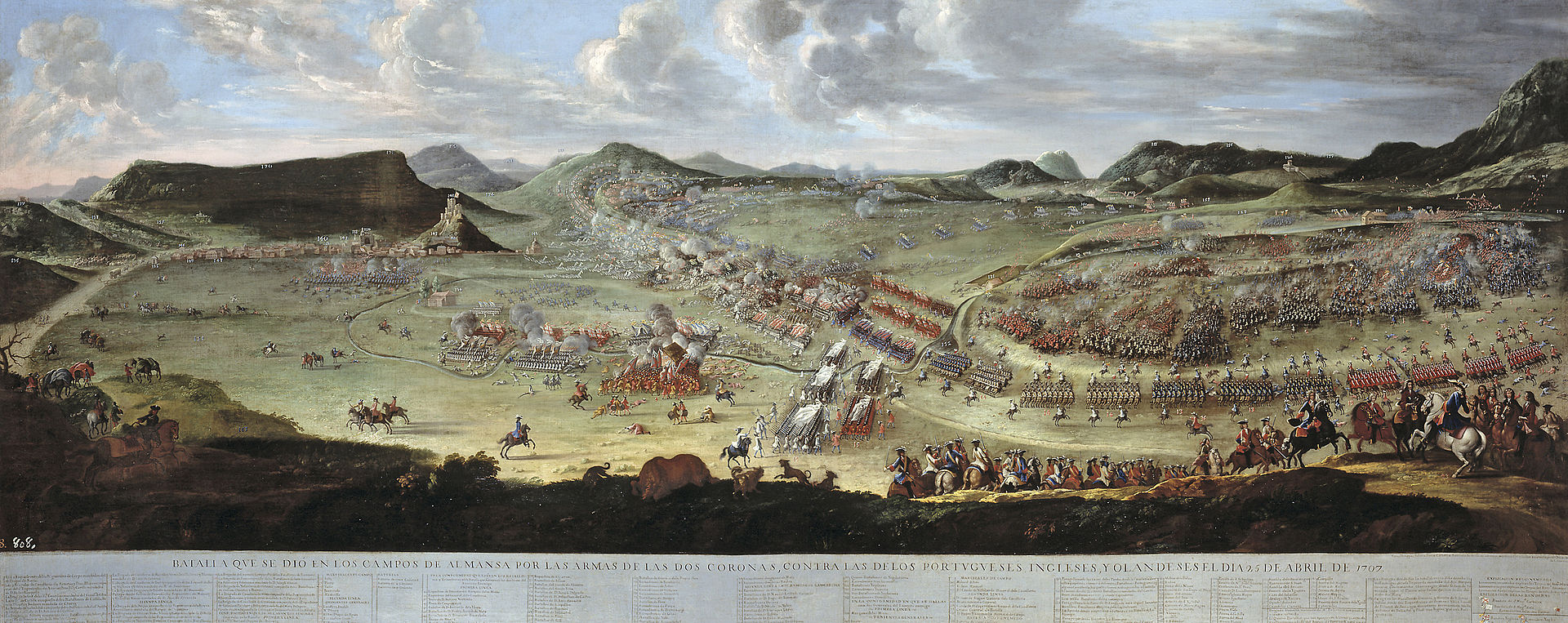
Battle of Almansa, 1707. The victory of the Franco-Spanish Bourbon army at Almansa in Spain was a serious setback for the Grand Alliance

Battle of Almansa, 1707. The victory of the Franco-Spanish Bourbon army at Almansa in Spain was a serious setback for the Grand Alliance
( Click image to enlarge)
Following the Habsburg victory in Italy the Emperor could at last send Charles III assistance in early 1708. Joseph I's resources remained limited and he was still unwilling to assign a high priority to the war in Iberia. Nevertheless, the Austrians agreed to send reinforcements, as well as Guido Starhemberg to assume supreme Allied command in the peninsula. James Stanhope – the English envoy to Charles III – became the new British The Kingdom of Great Britain was a sovereign country in Western Europe from 1 May 1707 to the end of 31 December 1800. The state was created by the 1706 Treaty of Union and ratified by the Acts of Union 1707, which united the kingdoms of England (which included Wales) and Scotland to form a single kingdom encompassing the whole island of Great Britain and its outlying islands, with the exception of the Isle of Man and the Channel Islands. commander in Spain, and in September he and Admiral Leake captured Minorca and the key harbour, Mahón. This success followed hard on Leake's capture of Sardinia in the name of Charles III in August. However, Philip V's generals on the Spanish mainland continued their advance on Charles III in Barcelona. Orléans took Tortosa in mid-July, while on the Valencian coast d'Asfeld re-captured Dénia in mid-November, and Alicante (though not its citadel) in early December.
The Kingdom of Great Britain was a sovereign country in Western Europe from 1 May 1707 to the end of 31 December 1800. The state was created by the 1706 Treaty of Union and ratified by the Acts of Union 1707, which united the kingdoms of England (which included Wales) and Scotland to form a single kingdom encompassing the whole island of Great Britain and its outlying islands, with the exception of the Isle of Man and the Channel Islands. commander in Spain, and in September he and Admiral Leake captured Minorca and the key harbour, Mahón. This success followed hard on Leake's capture of Sardinia in the name of Charles III in August. However, Philip V's generals on the Spanish mainland continued their advance on Charles III in Barcelona. Orléans took Tortosa in mid-July, while on the Valencian coast d'Asfeld re-captured Dénia in mid-November, and Alicante (though not its citadel) in early December.
HISTORY
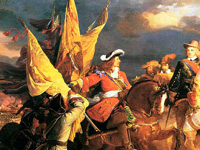
RESOURCES
This article uses material from the Wikipedia article "War of the Spanish Succession", which is released under the Creative Commons Attribution-Share-Alike License 3.0.
© Stories Preschool. All Rights Reserved.
